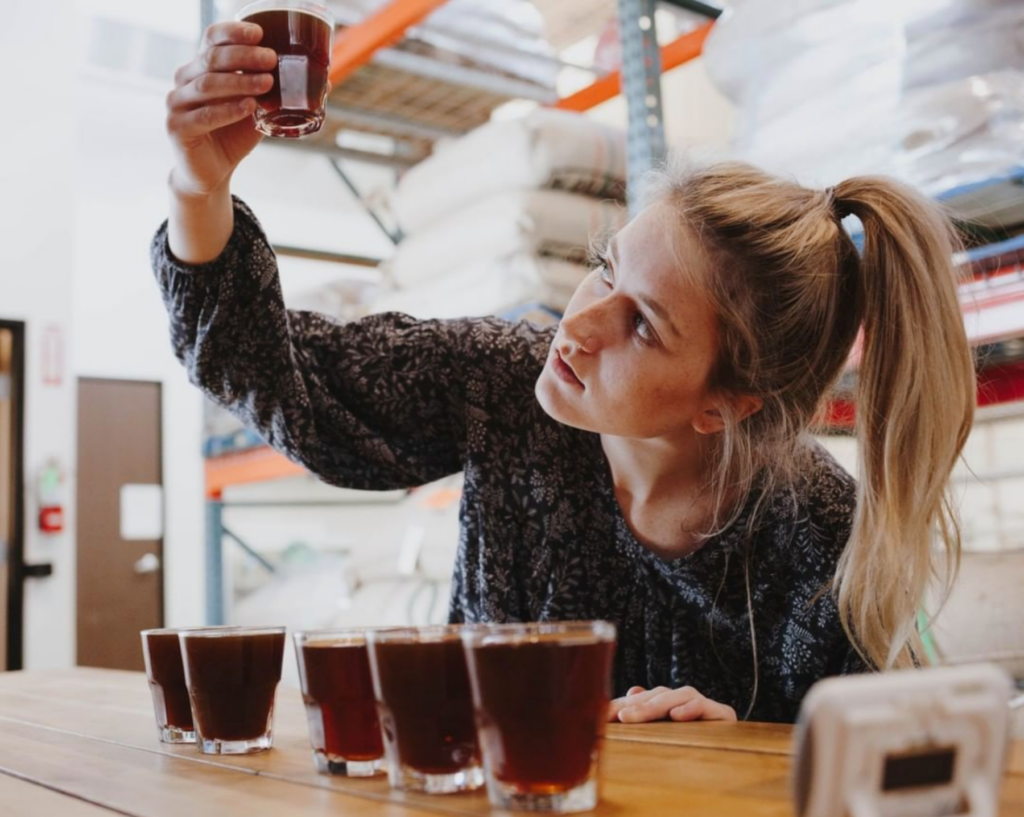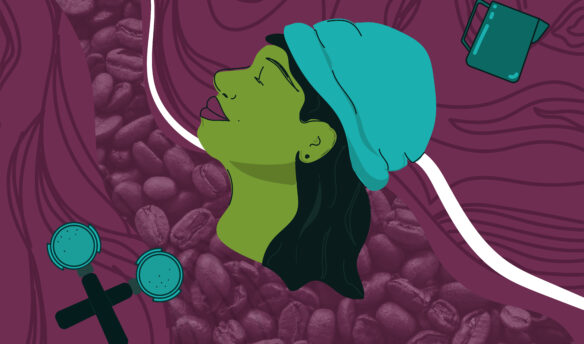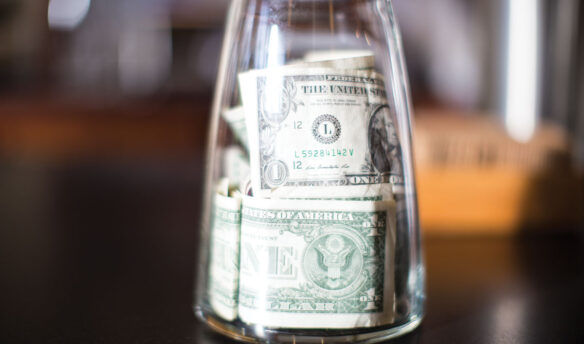Of all the skills a new barista must learn, efficiency is perhaps the most elusive. As long as the stage is set for success (well-designed cafe layout, the right tools, a solid team with solid goals), the next ingredient for an effortless bar flow is usually just time spent repeating the motions.
But could there be a more efficient way to speed up the process? Here are five tricks from trainers to trainers for teaching efficiency from a barista’s first day and beyond.
Start Sooner, Start Slower
Efficiency is often discussed as a matter of bar efficiency: can you make a queue of lattes and cappuccinos quickly? But you don’t have to wait until a new barista is trained to make drinks to start talking about efficiency.
There are learning moments in every corner of the cafe, from managing a line while working the register to doing the dishes. The barbacks at Colectivo Coffee Roasters play a crucial role in getting orders ready for baristas: they sticker tickets to cups, add syrups, and prepare ice for iced drinks.
“The two positions [barista and barback] work in tandem,” says Kyle Conner, senior training manager for Colectivo. “If that person isn’t trained properly and early, it only serves as a detriment to the efficiency of the cafe.”
When it finally comes time for someone to work the espresso machine, it’s best to start slow. Make sure they understand how all the equipment works, how to pull a shot, and how to steam milk to your cafe’s standards. The most important thing, Conner says, is not only to demonstrate the steps, but to let the baristas perform them.
“More often than not, people fear messing up or looking dumb,” he says. As a trainer, he prioritizes creating a safe space for making mistakes early and often. “It makes much more sense to celebrate all outcomes, successful or not, because you’re still growing in both cases.”
Though it may feel tedious to outline every detail of espresso preparation, don’t gloss over the little things. The habits a new employee learns on day one become the foundation for their future, especially if it’s their first barista job, says Elise Jones, director of education at Temple Coffee.
“Implementing speed too early,” she says, “can lead to simple mistakes due to rushing.”
Know The Roles
Baristas should know exactly what they’re responsible for: Who greets customers? Who fills the ice bin? Who is pulling shots, steaming milk, or bussing tables? When roles aren’t clearly defined, people start (quite literally) stepping over each other.
Try drawing a map of the cafe, outlining the jobs baristas might find themselves doing during a shift. I’ve seen cafes where folks are limited to specific zones with masking tape and others where roles are entirely fluid. As always, it’s best to consider your team, space, and goals; there’s not necessarily a “right” way to do this.
At Greater Goods Coffee, where I’m a trainer, we took a more laissez-faire approach during the pandemic. With so much unpredictability, it made sense to encourage baristas to choose their roles based on the day’s needs, especially regarding customer interactions. A six-hour cashier shift is exhausting, notwithstanding the fear of COVID-19, so baristas had the freedom to camp out behind the espresso machine if they were having an off day.
These days, supporting our team looks slightly different. We’re incorporating more structure to eliminate uncertainty and evenly distribute tasks so no one gets burnt out on any position. Roles are laid out in advance, and shifts include scheduled rotations. Every barista has a chance to steam milk, do dishes, and help customers.
Whenever possible, work together to discover what’s most efficient, says Ali Abdherraman, regional educator for Counter Culture Coffee in Dallas.
“The entire team is responsible for pacing the drinks,” he said. “The energy they keep behind the bar is the one that customers will respond to.”
Roleplay and Instant Replay
If you’re lucky enough to work at a cafe with a training lab, use that space to rehearse real-world scenarios.
In the Specialty Coffee Association (SCA) Barista Skills Intermediate module, students are judged on their ability to make two single-shot cappuccinos. While this demonstrates the barista’s ability to craft a specialty coffee beverage, it does little to prepare them for the reality of a Friday morning rush.
It’s more effective to pull actual transactions from peak hours at your cafe, practice making regular customers’ drinks, and incorporate a healthy dose of stress to instill a sense of urgency.
At Temple, Jones and her team of trainers do “partner runs,” where one person acts as the barista and the other as the customer, asking questions and trying to distract the barista while they work.
“It gives them a taste of what being a barista is like in our stores and is a great way to practice effective communication, roles, multi-tasking, and speed,” she says.
After his initial training sessions in the Counter Culture lab, Abdherraman makes regular cafe visits to observe baristas during service. He assesses their workflow, then reviews performance during downtime, he says.
Being a trainer is all about watching and listening, but sometimes baristas don’t remember the nuances of what they did or didn’t do during a rush. Everything happens quickly, and details get blurry when the mind is flowing.
Conduct Timed Trials
Once baristas feel confident in their mechanical skills, trainers often introduce timed challenges to put them to the test. Both the intermediate and professional levels of the SCA Barista Skills modules involve timed exams, doubling down on the idea that a great barista must be efficient and proficient.
Timed trials are the culmination of 100 hours of training for Temple baristas, says Jones. “A barista’s final exam is to make ten drinks with proper temperature, texture, foam amounts, and latte art in 20 minutes,” she says. “Drinks are consistently delicious; service never takes a hit if a new barista is on bar.”
At Colectivo, timed challenges aren’t just a metric of success; they’re also a fun way to motivate baristas, says Conner.
“If a person truly is getting bored while training, then my default will always be to make a game of whatever we’re doing,” he says. “Think you’ve got your order of operations down? Let’s see how many drinks you can do in a certain amount of time.”
Learn the Language
Do you write on cups? Train the shorthand. Do your tickets pop up on a tablet? Teach how to decode them, focusing on the details that are often missed, like quantities of shots or pumps of syrup and iced versus hot. Efficient baristas are expert communicators; a trainer’s job is to give them the vocabulary to succeed from the get-go.
Make flashcards or slides of drink orders, then test a barista’s ability to recall and relay the order as quickly and concisely as possible to their team. Although communication and prioritizing are soft skills (rather than the tangible, hard skills of making coffee and working a register), they’re no less critical to the success of your cafe—and vital to running an efficient service.
When tickets pile up, and the pressure is on, baristas need to feel empowered to make quick decisions. For example, making drinks precisely in the order they came in isn’t necessarily efficient. If a customer orders a coffee with an extra shot during a rush, it’s much more efficient to take care of that sooner rather than have a hot coffee sitting on the counter behind a string of latte orders.
Which drinks can be made together? If a traditional macchiato and a latte with the same milk pop up a few tickets apart, it’s a good idea to steam the same milk for both beverages.
Furthermore, in what order do you prep the shot, the milk, the syrup? When do you need to ask for help? Sometimes asking these questions is enough to inspire a barista to prioritize quickly.
Repetition, Repetition, Repetition
Even after incorporating these training techniques, nothing compares to hours on shift. “Just do it” is good advice, but remember that consistency is key when developing good bar flow techniques. Repeat the same steps over and over, as slow and as often as you need, and eventually, it will result in muscle memory, says Abderrahman.
“One day, it will just click, and they’ll crush the rush without thinking about it,” he says.
If you feel like you’ve tried everything you can as a trainer and a barista is still struggling with bar flow, keep going. According to Conner, training isn’t always linear, and sometimes things click at different moments for different people.
“You need to meet a person where they’re at. Period,” he says. “For just as many hands-on learners, we have plenty who need hard facts.” His training sessions incorporate activities for all learning styles, from written milk weights to latte art videos.
More than anything, it’s vital to stay optimistic. Efficiency is difficult to train, but just showing up and trying is half the battle. Be careful not to mistake a lack of skills for a lack of confidence, advises Jones.
“Learning a new trade is immensely tiring and intimidating,” she said. “Having the support of their leaders or co-workers who are giving positive and encouraging feedback can do wonders for baristas’ confidence.”
Cover photo by Elise Jones

















